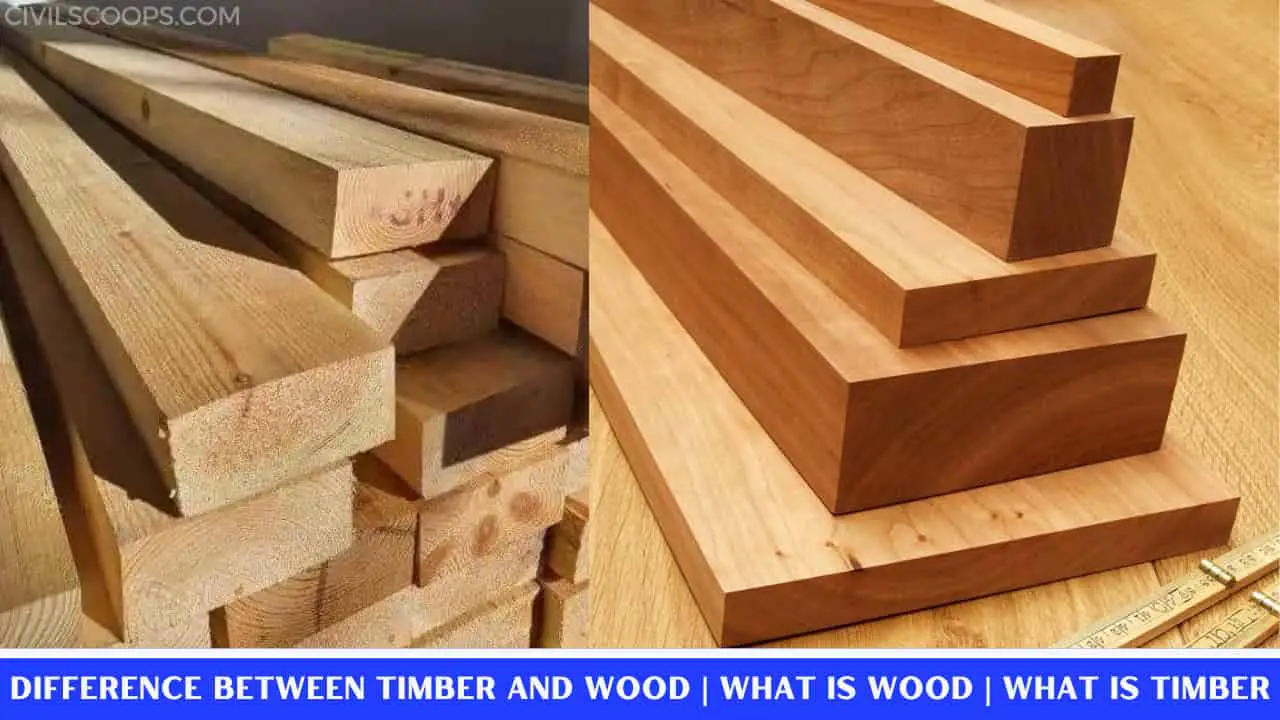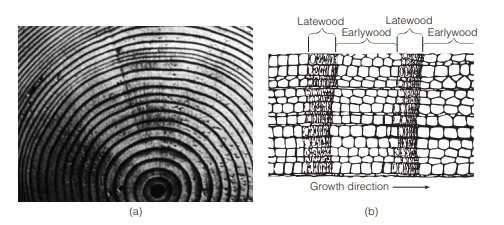Difference Between Timber And Wood | What is Wood | What is Timber

Table of Contents
Difference Between Timber And Wood: What
What Is Wood?
Wood is a tough and fibrous substance which forms a major portion of the branches and trunk of a tree. In addition, it can be defined as a natural polymeric material which practically does not age. Wood, as a construction material, falls in two major categories –man-made and natural.
With all the advances at science and technology, wood in its natural form as timber, lumber, etc., is being quickly replaced by composite wood materials where natural wood is no more than a basic part of a matrix or a laminate.
The latter is found to be more useful and adaptable as they may be treated chemically, thermally or otherwise as per requirements. Some examples are plywood, fibre boards, chipboards, compressed wood, impregnated wood, etc.
Wood has many advantages because of which it is preferred over a number of other building materials. It’s easily available (this will not be true after a while ) and easy to handle and transport, has more thermal insulation, sound absorption and electrical resistance as compared to steel and concrete.
It is the ideal material to be used in seawater. Wood is a good absorber of shocks and so is suitable for construction work in hilly areas which are more prone to earthquakes. Finally, since wood can be easily worked, repairs and alterations to woodwork can also be done easily.
Owing to the above-mentioned advantages, wood is very widely used in buildings as doors, windows, frames, temporary partition walls, etc. and in roof trusses and ceilings apart from the formwork.
What Is Timber?
The terms wood and timber are often used synonymously, but they also have distinct meanings in the building Industry.
Wood is the tough, fibrous material which makes up the tree under the bark, whereas timber might be defined as a wood which retains its natural bodily structure and chemical composition and is suitable for various engineering works.
After is That the classification of timber According to IS: 399, except the classification of timber According to grading That’s given in, IS: 6534.
Timber vs Wood: Characteristics
Characteristics of Wood
Here, the list of characteristics of wood are as follows.
- Formation
- Growth rings
- Earlywood
- Springwood
- Latewood
- Summerwood
- Knots
- Color
- Structure
- Ring porous species
- Diffused porous woods
- Earlywood and latewood in softwood
- Early v ad and latewood in ring-porous woods
- Earlywood_and latewood in diffuse-porous woods
- Monocot wood
- Water content
Characteristics of Good Timber
The principal characteristics of timber of concern are strength, durability, and finished appearance.
- Narrow annual rings, closer the rings greater is the strength.
- Compact medullary rays.
- Dark color.
- Uniform texture.
- The sweet smell and a shining fresh cut surface.
- When struck sonorous sound is produced.
- Free from the defects in timber.
- Heavyweight.
- No woolliness at the fresh-cut surface.
Timber vs Wood: Structure
Structure of Wood
Wood has a distinct structure that affects its use as a construction material. Civil and construction engineers need to understand the way the tree grows and the anisotropic nature of wood in order to properly design and construct wood structures.
1. Growth Rings
The concentric layers at the stem of exogenous trees are called growth rings or annual rings, as shown in as per figure. The wood produced in a single growing season constitutes a single growth ring. Each annual ring is composed of earlywood, produced by rapid growth during the spring, and latewood from summer growth.
2. Latewood
Latewood consists of dense, dark, and thick-walled cells producing a stronger structure than early-wood, as shown in Figure 10.3b.
The predominant physical features of the tree stem include the bark, cambium, wood, and pith, as shown in Figure 10.4.
3. Bark
The bark is your exterior covering of the tree and contains an outer and an inner layer. The outer layer is dead and corky and contains great variability in thickness, determined by the species and age of this tree. The inner bark coating is the growth layer for bark but isn’t part of the wood section of the tree.
4. Cambium
The cambium is a thin coating of cells situated between the wood and the bark and is the location of all wood growth.
Also Read: Requirements of Good DPC | Prevention of Dampness | Methods of Damp proofing
5. Wood Section of the Tree
The wood section of the tree is composed of sapwood and heartwood. Heartwood is often darker colored and occurs at the center of the cross-section and is surrounded by sapwood.
Sapwood functions as a storehouse for Both starches and as a pipeline to transport sap. Generally, faster-growing species have thick sapwood regions. In its natural state, sapwood is not durable when exposed to conditions that promote decay.
Heartwood is not a living part of the tree. It is composed of cells that have been physically and chemically altered by mineral deposits. The heartwood provides structural strength for the tree. Also, the heartwood of some species is decay-resistant due to the presence of extractives.

Cross-section of a typical tree system a) Annual rings b) Earlywood and Latewood
Most of the species used in the U.S. do not have decay-resistant heartwood. A few species, such as redwood and cedar, are recognized as having durable heartwood. The Wood Handbook (USDA-F’S, 1999) lists species based on the decay resistance of heartwood. The extractives present in some heart-wood can also protect the wood from termites.
6. Pith
This pith is the central core of the tree. Its size varies with the free species, ranging from barely distinguishable to large and conspicuous. The color ranges from blacks to whitish, depending on the tree species and locality. The pith structure can be solid, porous, chambered, or hollow.
Structure of Timber
A tree can be divided into three portions, crown—composed of branches and leaves, trunk, and roots. The trunk accounts for about 80 percent of the total bulk of the wood. As per below figure shows the structure of well-grown timber from the trunk of the exogenous tree.
The structure of timber visible to the naked eye or at a small magnification is called macrostructure, and that appears only at great magnifications, the microstructure. Macrostructure of the timber can be studied by cutting the trunk in three directions (as per below figure (a)).
In the cross-sectional and radial ducts, the following main parts of a tree, e.g., bark, cambium, sapwood, heartwood, and pith, become readily apparent (as per below figure (b)). Each of the components has a specific function.
The bark protects the wood against mechanical damage. Its inner layer, called bast, conveys the nutrients from the crown downwards and stores them.
The function of cambium is to grow wood cells on the inside and smaller bast cells on the outside. The sapwood assists in the life process of a tree by storing up starch and conducting sap. The cells in the sapwood are active. The heartwood gives strong and firm support to the tree.
With the growth of the tree, the cells in the inner older portion of trunk gradually become inactive and lifeless but do not decay. This portion of the trunk is called heartwood. At the center of the cross-section is the pith, a small area occupied by friable tissues consisting of thin-walled, loosely connected cells called pith

Cross Section of a Tree
In a felled tree, it easily crumbles and rots. In the cross-sectional direction, nutrients pass from bast to the heart through groups of cells running at right angles to the cambium layers and are referred to as medullary rays.
Difference Between Timber And Wood
[su_table responsive=”yes”]
| Sr.No. | Wood | Timber |
| 1 | Wood is used for various purposes. | Timber is only used for industries and construction purposes. |
| 2 | Wood cover with the trees. | Timber is made a nest |
| 3 | ‘Wood’ is used to apply to the material that makes the tree and transfer water and nutrition. | Timber is one type of wood. This is used after the tree has been fall down or crushed. |
| 4 | The wood material can be made with a pencil, toothpick, stick, etc. | Timber is a bigger wooden substance |
| 5 | Wood is a fiber substance or rubbery which is out from plants or vegetation. | Wood transformed into girders, beams, and boards. |
| 6 | Wood is processed wood. | Timber is unprocessed wood. |
| 7 | Wood is used for flooring, truss, for making storage containers, plywood, veneers, log, etc. | Timber is used for furniture, firebreaks, beam, other construction purpose, paper pulp, etc. |
| 8 | The central part of the trunk and branches are making up a substance that is used as a construction material. | The forest trees are considered a source of wood |
| 9 | Wood is directly collected from the forest. | Timbers are made up of a straight wooden log. |
| 10 | Wood is rough wood. | Timber is finished wood. |
| 11 | Wood is simply the material name all timbers and logs are made from in it. | Timber is a simple wooden log and then converted into the beam, board, the shape of the rafter, etc. |
[/su_table]
[su_box title=”FAQ” style=”default” box_color=”#333333″ title_color=”#FFFFFF” radius=”3″ class=”” id=””]
Timber Wood
Timber is a type of wood which has been processed into beams and planks. It is also known as “lumber” in US and Canada. Basically, timber or Lumber is a wood or firewood of growing trees. Timbers are used for the structural purpose.
Exogenous Trees
Trees which grow outwards and increase in bulk by the formation of successive annual rings are known as exogenous trees. Exogenous Trees Structure. Timber which is used for building engineering works,Is Mostly obtained from exogenous trees. Examples : Deodar, Kail, Sal, Teak, Shishum, Chir etc.
Characteristics of Good Timber
A timber is said to be good based on the following characteristics :
- Durability
- Strength
- Permeability
- Hardness
- Toughness
- Elasticity
- Workability
- Weight
- Structure
- Defects
- Fire resistance
- Mechanical wear
- Appearance
- Colour
- Shape
- Smell
- Sound
What Is Timber Wood?
Timber is a type of wood which has been processed into beams and planks. It is also known as “lumber” in US and Canada. Basically, timber or Lumber is a wood or firewood of growing trees. Finished timber is supplied in standard sizes for the industry. Timber is used for building houses and making furniture.
[/su_box]
[su_note note_color=”#F2F2F2 ” text_color=”#333333″ radius=”3″ class=”” id=””]
Like this post? Share it with your friends!
Suggested Read –
- Concrete Release Agent | Concrete Form Release Agent | Concrete Formwork Release Agent | Concrete Form Release Oil | Concrete Mold Release Agent
- What Is Timber ? | What Is Lumber ? | What Is Lumber Used for ? | Lumber Vs Wood | Difference Between Lumber and Timber | Standard Wood Size | What Is Timber Used for ?
- Concrete Slump Test | Principle of Slump Test | What Is Slump Test ? | How to Measure Concrete Slump? | Slump Test Results | Concrete Slump Test Procedures
- Difference Between Coarse Aggregate and Fine Aggregate | What Is Coarse Aggregate? | What Is Fine Aggregate? | Advantage of coarse aggregates | Advantage of Fine Aggregate
- Concrete Vs Cement | Definition of Cement and Concrete | Composition of Cement and Concrete | Types of Cement and Concrete | Properties of Cement and Concrete
[/su_note]
Originally posted 2022-08-06 13:42:34.
